For a waterworks system to ensure reliable, long-lasting services, it’s critical that a fundamental component be efficient resource allocation. By incorporating capital efficiency plans, master plans, and a methodical capital planning process, utilities are able to navigate the complexities of their industry, not only by enabling them to strategically allocate resources and address dire infrastructure needs but also by meeting the persistent demands of evolving environmental regulations.
As we forge ahead, smart capital planning remains the compass that guides utilities towards a future where access to clean water is not just a necessity but a sustainable and well-managed reality.
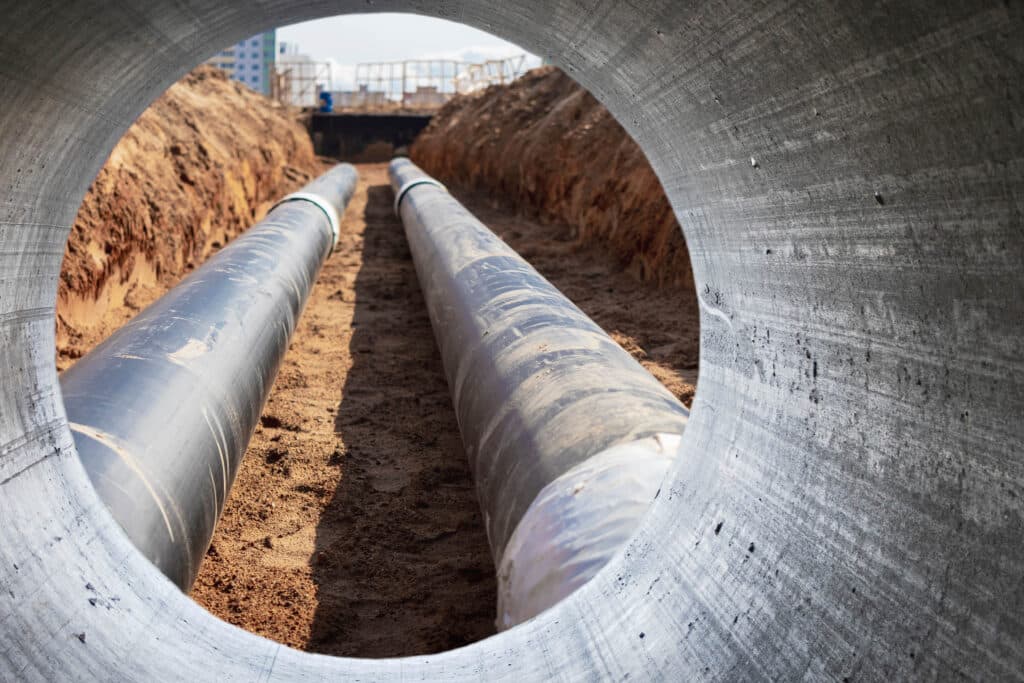
Capital Efficiency Plans (CEPs): The Blueprint for Resource Organization
Capital Efficiency Plans (CEPs) at T&H follow a standard Venn diagram method. For every water main segment, there are three sets of evaluation criteria: key components, asset management, and hydraulic modeling.
With each set comes its own set of unique drawbacks, and it’s where the three overlap that the system’s weak points are put on display. If it seems that the weaknesses meet more than one set of criteria, then they are swiftly prioritized above the others as they require the most attention. By choosing this type of visual method, CEPs can quickly and justifiably pinpoint areas of criticality, allowing utilities to make a targeted plan of attack.
To put it simply, CEPs are a vital element of smart capital planning because they provide utilities with a strategic roadmap leading them towards the treasure trove of resource optimization. CEPs prioritize resource allocation by identifying the projects that will offer the greatest impact on efficiency (in other words, the ones that require the most attention), while also evaluating any potential risks such as regulatory changes and environmental challenges.
By streamlining capital investments, utilities can ensure cost-efficiency while also maintaining and improving their service standards and mitigating any potential, unforeseen issues.
Master Plans: The “What, When, and How” for Sustainable Development
A water master plan is essentially what it sounds like: a blueprint for sustainably managing and using water resources within a specific region. Diving deeper, a water master plan is a detailed framework that takes a variety of factors into account, like evaluating the current water supply, demand forecasts, infrastructure development, conservation tactics, financial planning, and environmental impact evaluations, to name a few.
Water, after all, is our lifeblood; without it, we could not sustain ourselves, our ecosystems, or our industries. It’s no secret that water utilities are often the ones on the front lines battling mitigation efforts, a lack of funding, and a complex web of other responsibilities. This juggling act often means that they need to know the “what, when, and how” as soon as possible: what do they need to do? When do they need to do it? How are they going to pay for it?
A water master plan has three main components: infrastructure assessment, data collection and analysis, and long-term goals. The first step is an infrastructure assessment that will evaluate the current water systems and infrastructure, including a review of pipelines, treatment plants, distribution networks, storage facilities, etc. This comprehensive evaluation will also be able to identify any infrastructure needs, such as maintenance, upgrades, or expansions.
The second step in any effective master plan is data collection and analysis. The master plan is constructed by using the initial assessment’s findings as its foundation—everything from demographic trends to industry developments can provide crucial information that can lead the plan down the path of success or failure. This step is important because it will influence the master plan. After all, bad data equals bad resource allocation. Thirdly, water master planning needs to extend far beyond the immediate needs; long-term goals are absolutely critical in ensuring the future of sustainable water management and utilization.
The heart of a water master plan is straightforward: ensure that water resources are allocated fairly, address critical issues like population growth and climate change, and establish a robust, accessible, and dependable water delivery system. Because at the end of the day, a water master plan promotes long-term water security, the health of people and ecosystems, and effective water management by integrating technical, economic, and environmental concerns.
Capital Planning
Utilities use the capital planning process, a structured methodology, to identify, prioritize, and allocate resources for capital projects. By addressing present demands and preparing for upcoming obstacles, this strategy helps utilities to align investments with strategic objectives. It starts with a thorough evaluation of the state of the infrastructure, which paves the way for the identification of priority projects that solve short-term issues and support long-term objectives.
An essential part of the planning process is estimating the price of proposed capital projects. Utilities use financial analysis to evaluate project viability and pinpoint possible funding sources, and a detailed risk assessment is carried out in order to identify and minimize any issues that could affect the success of capital projects. Investment resilience is increased by proactive risk management.
A financial analysis can help utilities determine just how feasible their projects are and aid in the search for funding by assessing their weaknesses in order to foresee any challenges that could impact the project’s success. Important stakeholders are then consulted to ensure the process takes into account a variety of viewpoints and community requirements. This cooperative and collaborative strategy not only promotes transparency, but it also has the power to greatly increase stakeholder trust.
Conclusion
In the face of a constantly evolving environment while meeting complex regulatory and social dynamics, there is no denying that smart capital planning is essential for the sustainable development of water and wastewater utilities. To put it succinctly, in order to have sustainable development, management, protection, and distribution of water and wastewater utilities, extensive planning is non-negotiable. Combined with ever-changing technology, utilities are further empowered to adapt and thrive.
By incorporating capital efficiency plans, master plans, and a methodical capital planning process, utilities can navigate the complexities with far more ease and effectively meet the needs of their communities.

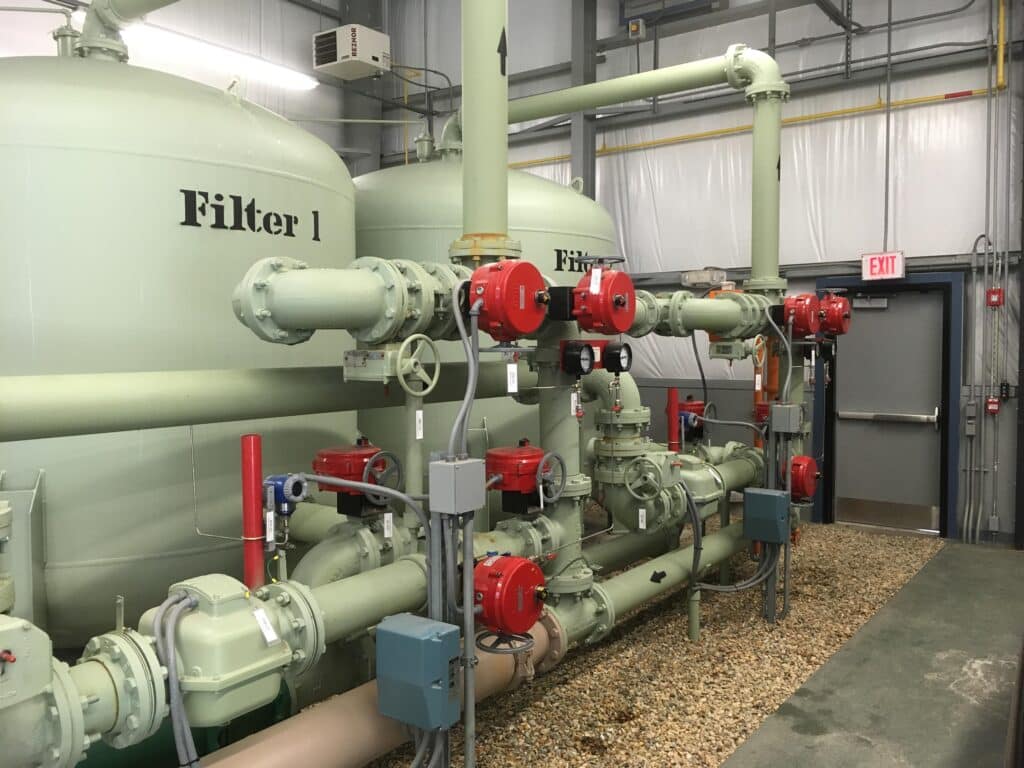
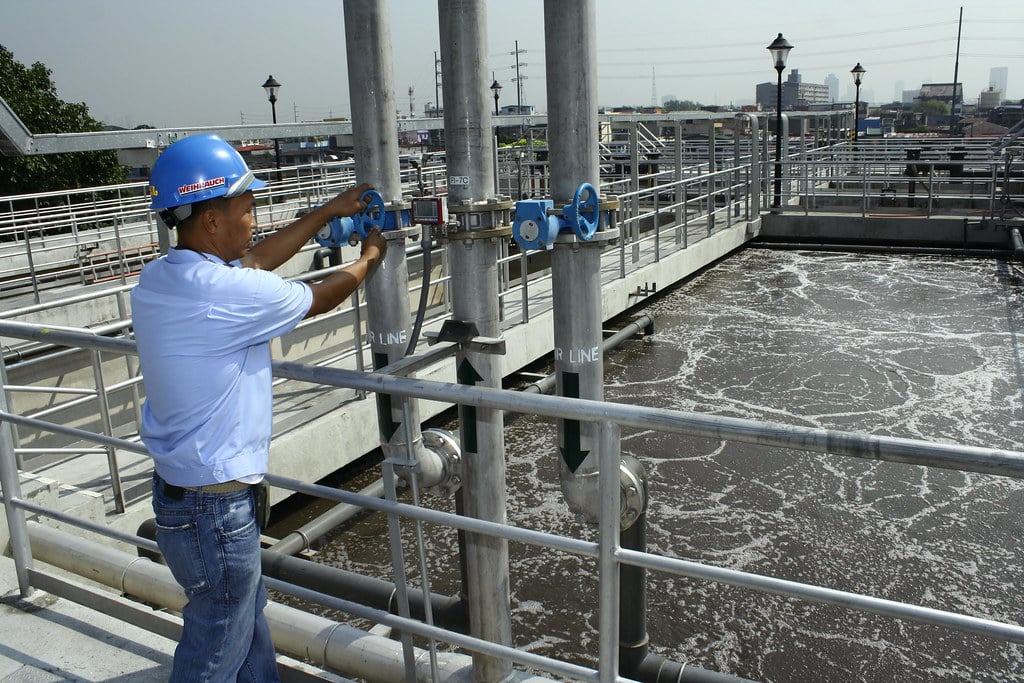 The Tata & Howard Capital Efficiency Plan (CEP) helps you do just that. Our CEP method is an accelerated and progressive approach to asset management. Our program allows municipalities, with the assistance and guidance of expert field staff and project managers, to do the following: (1) identify areas of their water, stormwater, and wastewater systems that are in need of repair, replacement, and/or rehabilitation; and (2) create a prioritized plan of action that is easily justified. In addition, the entire plan is conducted and completed in a way that makes the most bang out of municipalities’ limited infrastructure bucks.
The Tata & Howard Capital Efficiency Plan (CEP) helps you do just that. Our CEP method is an accelerated and progressive approach to asset management. Our program allows municipalities, with the assistance and guidance of expert field staff and project managers, to do the following: (1) identify areas of their water, stormwater, and wastewater systems that are in need of repair, replacement, and/or rehabilitation; and (2) create a prioritized plan of action that is easily justified. In addition, the entire plan is conducted and completed in a way that makes the most bang out of municipalities’ limited infrastructure bucks. Once the plan is completed, systems receive their CEP report, complete with Geographic Information System (GIS) representation for each pipe segment within their individual underground piping system, along with a database. Each report will detail what issues are critical and should be prioritized, and includes estimated costs for the repairs, replacements, or rehabilitations that need to be made, so critical and less-critical projects alike can be part of the conversation when preparing annual budgets.
Once the plan is completed, systems receive their CEP report, complete with Geographic Information System (GIS) representation for each pipe segment within their individual underground piping system, along with a database. Each report will detail what issues are critical and should be prioritized, and includes estimated costs for the repairs, replacements, or rehabilitations that need to be made, so critical and less-critical projects alike can be part of the conversation when preparing annual budgets.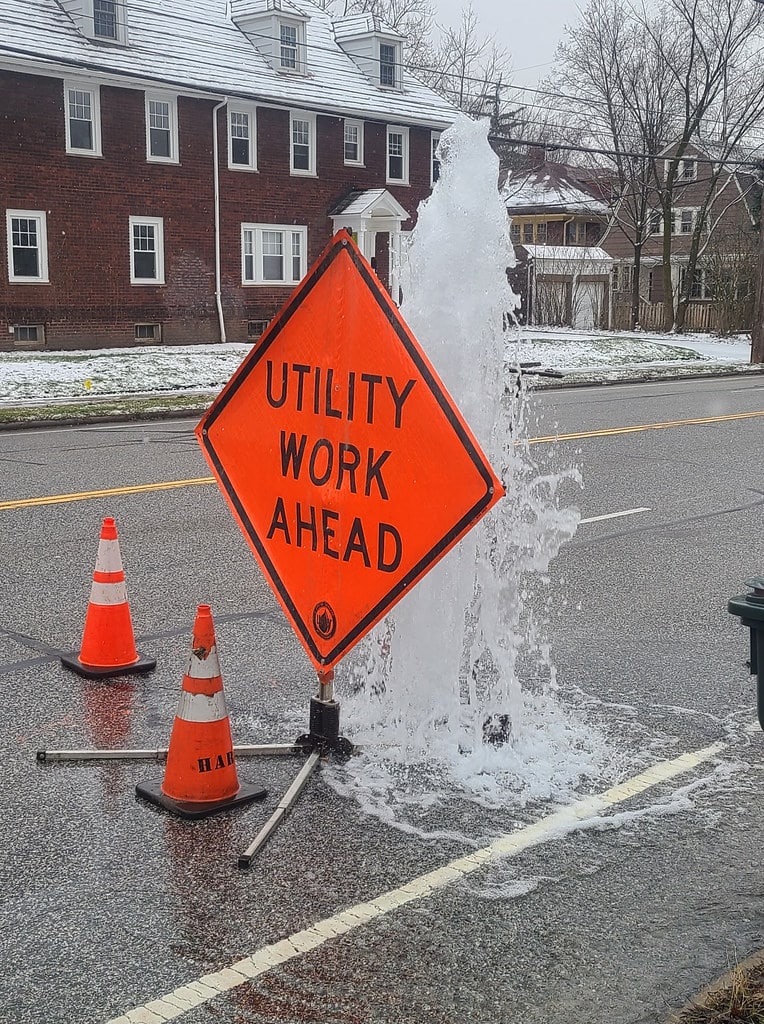 It has been no secret that federal and state funding has been on a steady decline for several decades now, starting in the mid-1970s. With already limited funding, state and local governments are unable to meet full capital expenditures and to prioritize projects, and are frankly falling behind, leaving their residents to bear the burden of crumbling infrastructure.
It has been no secret that federal and state funding has been on a steady decline for several decades now, starting in the mid-1970s. With already limited funding, state and local governments are unable to meet full capital expenditures and to prioritize projects, and are frankly falling behind, leaving their residents to bear the burden of crumbling infrastructure. Asset management planning is absolutely critical to the current and future health and maintenance of our water supplies. This highly structured, three-circle approach to capital planning is one of the most effective ways for systems to conclusively prioritize those that are in most need of repair, replacement, or rehabilitation. Each CEP approach is specifically tailored to each project, as each system and project have varying needs.
Asset management planning is absolutely critical to the current and future health and maintenance of our water supplies. This highly structured, three-circle approach to capital planning is one of the most effective ways for systems to conclusively prioritize those that are in most need of repair, replacement, or rehabilitation. Each CEP approach is specifically tailored to each project, as each system and project have varying needs.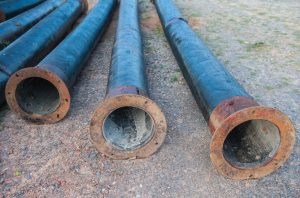 In recent years, water systems have been faced with challenges that are unique to modern times. Our nation’s buried infrastructure is reaching a critical juncture in that it is nearing or has reached the end of its useful life, or is in dire need of replacement due to the presence of lead. At the same time, climate change is affecting supplies, while a burgeoning population is creating a larger demand. And as we increase our knowledge about the dangers of additional contaminants in our drinking water, utilities are saddled with increased regulations that require strict compliance by specific deadlines. Obtaining compliance often requires extensive upgrades or completely new infrastructure, all of which come with a high price tag.
In recent years, water systems have been faced with challenges that are unique to modern times. Our nation’s buried infrastructure is reaching a critical juncture in that it is nearing or has reached the end of its useful life, or is in dire need of replacement due to the presence of lead. At the same time, climate change is affecting supplies, while a burgeoning population is creating a larger demand. And as we increase our knowledge about the dangers of additional contaminants in our drinking water, utilities are saddled with increased regulations that require strict compliance by specific deadlines. Obtaining compliance often requires extensive upgrades or completely new infrastructure, all of which come with a high price tag. The proposed 2018 budget also budget cuts the Environmental Protection Agency (EPA) by 31%, or $5.7 billion. The EPA provides funding to water systems through its Drinking Water State Revolving Fund (DWSRF) and Clean Water State Revolving Fund (CWSRF) programs, both of which “provide communities a permanent, independent source of low-cost financing for a wide range of water quality infrastructure projects.”2 Considering that almost all spending on critical infrastructure such as drinking water, wastewater, and transportation is provided by the public sector, these cuts are expected to make a huge impact on available funding for critical water infrastructure projects.
The proposed 2018 budget also budget cuts the Environmental Protection Agency (EPA) by 31%, or $5.7 billion. The EPA provides funding to water systems through its Drinking Water State Revolving Fund (DWSRF) and Clean Water State Revolving Fund (CWSRF) programs, both of which “provide communities a permanent, independent source of low-cost financing for a wide range of water quality infrastructure projects.”2 Considering that almost all spending on critical infrastructure such as drinking water, wastewater, and transportation is provided by the public sector, these cuts are expected to make a huge impact on available funding for critical water infrastructure projects.

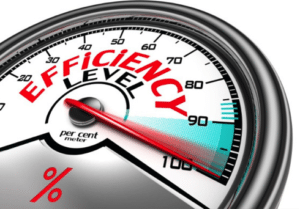 Water and wastewater utilities across the country face common challenges. These include rising costs, aging infrastructure, increasingly stringent regulatory requirements, population changes, and a rapidly changing workforce. While many utilities find themselves turning from one urgent priority to the next, others have implemented effective operational efficiency initiatives that have helped them enhance the stewardship of their infrastructure, improve performance in many critical areas, and respond to current and future demands. Improved efficiency is not just beneficial to a utility’s bottom line – it benefits everyone in a community.
Water and wastewater utilities across the country face common challenges. These include rising costs, aging infrastructure, increasingly stringent regulatory requirements, population changes, and a rapidly changing workforce. While many utilities find themselves turning from one urgent priority to the next, others have implemented effective operational efficiency initiatives that have helped them enhance the stewardship of their infrastructure, improve performance in many critical areas, and respond to current and future demands. Improved efficiency is not just beneficial to a utility’s bottom line – it benefits everyone in a community. A common problem facing many utilities today is a retiring work force. By implementing operational efficiency now, utilities can recruit and retain a workforce that is competent, adaptive, and correctly trained to take on leadership roles of their own. Through communication and effective training, utility owners and operators can create an organization focused on continual learning and improvement. This ensures employee knowledge is retained and improved upon. Over time, senior knowledge and best practices will be passed along to promote a well-coordinated senior leadership team who understands their system and the needs of its customers.
A common problem facing many utilities today is a retiring work force. By implementing operational efficiency now, utilities can recruit and retain a workforce that is competent, adaptive, and correctly trained to take on leadership roles of their own. Through communication and effective training, utility owners and operators can create an organization focused on continual learning and improvement. This ensures employee knowledge is retained and improved upon. Over time, senior knowledge and best practices will be passed along to promote a well-coordinated senior leadership team who understands their system and the needs of its customers. Some practices that utilities are implementing greatly help to improve resiliency and reduce vulnerability to an ever changing climate. Internal practices and initiatives such as energy conservation, solar energy, and utilizing heat transformed into energy from sewage and digestion have helped utilities rely less on the grid and more on their own operations. This is especially beneficial considering the ever-increasing price of energy. Reducing energy use significantly lowers operational costs for utilities – freeing up dollars for future initiatives or infrastructure improvements. Utilities who practice operational efficiency understand that making internal practices more efficient results in the entire distribution system becoming more efficient.
Some practices that utilities are implementing greatly help to improve resiliency and reduce vulnerability to an ever changing climate. Internal practices and initiatives such as energy conservation, solar energy, and utilizing heat transformed into energy from sewage and digestion have helped utilities rely less on the grid and more on their own operations. This is especially beneficial considering the ever-increasing price of energy. Reducing energy use significantly lowers operational costs for utilities – freeing up dollars for future initiatives or infrastructure improvements. Utilities who practice operational efficiency understand that making internal practices more efficient results in the entire distribution system becoming more efficient. Wastewater. It’s something that will always exist, and will always require collection and treatment. Just like improved water, improved sanitation is one of the key contributing factors to a developed nation, significantly improving public health, educational opportunity, and workforce viability. And while the United States boasts nearly 100% improved water and sanitation, there is still cause for concern.
Wastewater. It’s something that will always exist, and will always require collection and treatment. Just like improved water, improved sanitation is one of the key contributing factors to a developed nation, significantly improving public health, educational opportunity, and workforce viability. And while the United States boasts nearly 100% improved water and sanitation, there is still cause for concern.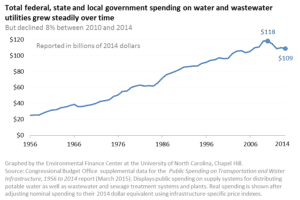 In March of 2015, the Congressional Budget Office (CBO) published a report on annual government expenditures on infrastructure, titled
In March of 2015, the Congressional Budget Office (CBO) published a report on annual government expenditures on infrastructure, titled 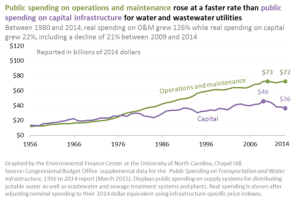 To further complicate matters, capital expenditure has decreased at a faster rate than O&M expenditure. From 1956 to 1980, public spending was basically split between capital expenditures — to build or replace water and wastewater systems — and O&M of the systems. However, since 1980, O&M spending continued to grow at an annual rate of 4%-6% to the 1990s, and then at an annual rate of 1%-3% through 2009, since when it has remained flat. In contrast, capital spending grew at an annual rate of only about 1%-2% since 1980, and has declined at an average annual rate of 4% since 2009. Governments now spend twice as much on O&M of their existing systems than on capital expenditures to repair, rehabilitate, or replace existing assets or for the installation of new infrastructure. In addition, state and local government is now saddled with nearly the full burden of capital expenditure, as federal spending has been steadily on the decline since 1976.
To further complicate matters, capital expenditure has decreased at a faster rate than O&M expenditure. From 1956 to 1980, public spending was basically split between capital expenditures — to build or replace water and wastewater systems — and O&M of the systems. However, since 1980, O&M spending continued to grow at an annual rate of 4%-6% to the 1990s, and then at an annual rate of 1%-3% through 2009, since when it has remained flat. In contrast, capital spending grew at an annual rate of only about 1%-2% since 1980, and has declined at an average annual rate of 4% since 2009. Governments now spend twice as much on O&M of their existing systems than on capital expenditures to repair, rehabilitate, or replace existing assets or for the installation of new infrastructure. In addition, state and local government is now saddled with nearly the full burden of capital expenditure, as federal spending has been steadily on the decline since 1976.
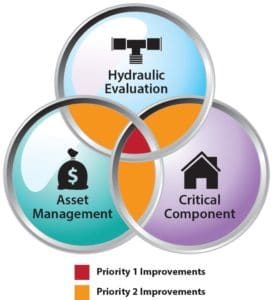 Hydraulic modeling
Hydraulic modeling To continue as a leading industrialized nation, our wastewater utilities must not only remain safe and functional, but also progressive and up to date with current and future regulations. Because funding is declining while costs and population are increasing, it is more important than ever for wastewater utilities to methodically prioritize and plan all repairs and improvements. Only through the implementation of a well-researched and systematic course of action will utilities be prepared to provide safe and dependable wastewater services both now and in the future.
To continue as a leading industrialized nation, our wastewater utilities must not only remain safe and functional, but also progressive and up to date with current and future regulations. Because funding is declining while costs and population are increasing, it is more important than ever for wastewater utilities to methodically prioritize and plan all repairs and improvements. Only through the implementation of a well-researched and systematic course of action will utilities be prepared to provide safe and dependable wastewater services both now and in the future.